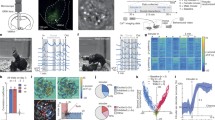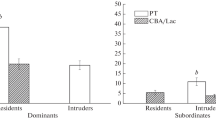Abstract
Social recognition has been inferred from a decline in olfactory investigation of conspecific intruders during repeated or protracted confrontation with a resident rat. A stimulus-response relationship defined by lack of response remains somewhat ambiguous. Since it is likely that behavior continues to be emitted by the resident animal, how behavior reorganizes as the resident becomes familiar with an intruder represents an important issue in the characterization of recognition. We examined the decline in olfactory investigation of ovariectomized females by adult male mice. The duration and frequency of olfactory investigation was measured during four 1 minute confrontations with 10-min intertrial intervals (Training trials). If the same female was presented in each trial, investigation declined to less than 50% of initial levels. Aggressive behavior gradually increased with repeated trials. No decline in investigation or increased aggression was measured when females were changed in each trial. Administration of doses of scopolamine (0.16–1.0 mg/kg, IP) blocked decrements in olfactory investigation in repeated confrontations and significantly reduced aggression. Co-administration of heptylphysostigmine (0.32–5.0 mg/kg, IP) reversed scopolamine's effects on olfactory investigation but not aggression. Acetylcholinesterase inhibitors heptylphysostigmine, galanthamine (0.63–2.5 mg/kg, IP) and tacrine (0.63–10.0 mg/kg, IP) all enhanced the rate of decrement of olfactory investigation when administered alone, but had differential effects on aggression. The decline in investigation corresponds to criteria for habituation. Increased responsivity expressed as aggression indicates recognition may also be characterized as a change in behavioral strategy dependent on the sexual and social status of the stimulus animal. Pharmacological data support a role for acetylcholine release in the development of social recognition as an olfactory memory, or through modulation of olfactory perception.
Similar content being viewed by others
References
Bell R, Warburton DM, Brown K (1985) Drugs as research tools in psychology: cholinergic drugs and aggression. Neuropsychobiology 14[4]:165–212
Beninger RJ, Jhamandas K, Boegman RJ, El-Defrawy SR (1986) Effects of scopolamine and unilateral lesions of the basal fore-brain on T-maze spatial discrimination and alternation in rats. Pharmacol Biochem Behav 24:1353–1360
Beuzen A, Belzung C, Roullet P (1994) Drug effects in a radial maze designed for dissociation of cues used by mice. Pharmacol Biochem Behav 48[1]:23–29
Bickel U, Thomsen T, Weber W, Fischer JP, Bachus R, Nitz M, Kewitz H (1991) Pharmacokinetics of galanthamine in humans and corresponding cholinesterase inhibition. Clin Pharmacol Ther 50[4]:420–428
Bluthe RM, Dantzer R (1992) Chronic intracerebral infusions of vasopressin and vasopressin antagonist modulate social recognition in the rat. Brain Res 572:261–264
Bluthe RM, Dantzer R (1993) Role of the vomeronasal system in vasopressinergic modulation of social recognition in rats. Brain Res 604:205–210
Bluthe RM, Schoenen J, Dantzer R (1990) Androgen dependent vasopressinergic neurons are involved in social recognition in rats. Brain Res 519:150–157
Charpentier J (1969) Analysis and measurement of aggression in mice. In: Garattini S, Sigg EG (eds) Aggressive behavior. Excerpta Medica Foundation, Amsterdam, pp 86–99
Dantzer R, Tazi A, Bluthe RM (1991) Cerebral lateralization of olfactory-mediated affective processes in the rat. Behav Brain Res 457:53–60
Dluzen DE, Kreutzberg JD (1993) 1-Methyl-4-phenyl-1,2,3,6-tetrahydropyridine (MPTP) disrupts social memory/recognition processes in the male mouse. Brain Res 609[1–2]:98–102
Donat P, Krsiak M (1982) Effects of scopolamine on agonistic behaviour of aggressive and non-aggressive mice. Acta Nerv Super 24:279–280
Fibiger H (1991) Cholinergic mechanisms in learning, memory and dementia: a review of recent evidence. Trends Neurosci 14:220–223
Gheusi G, Bluthe R-M, Goodall G, Dantzer R (1994) Ethological study of the effects of tetrahydroaminoacridine (THA) on social recognition in rats. Psychopharmacology 114:644–650
Giacobini E (1991) The second generation of cholinesterase inhibitors: pharmacological aspects. In: Becker R, Giocobini E (eds) Cholinergic basis for Alzheimer therapy. Birkhauser, Boston, pp 247–262
Hasselmo ME, Bower JM (1993) Acetylcholine and memory. Trends Neurosci 16[6]:218–222
Hughes RN, Trowland R (1976) Physostigmine effects on activity and reactions to novelty. Life Sci 19:793–796
Hunter AJ, Murray TK (1989) Cholinergic mechanisms in a simple test of olfactory learning in the rat. Psychopharmacology 99[2]:270–275
Kandel ER, Schwartz JH, Jessell TM (1991) Principle of neural science, 3rd edn. Elsevier, New York
Krsiak M, Sulcova A, Tomasikova Z, Dlohozkova N, Kosar E, Masek K (1981) Drug effects on attack defense and escape in mice. Pharmacol Biochem Behav 1:47–52
Kruk M (1991) Ethology and pharmacology of hypothalmic aggression in the rat. Neurosci Biobehav Rev 15[4]:527–538
Lemaire M, Piot O, Roques BP, Bohme GA, Blanchard J-C (1992) Evidence for an endogenous cholecystokininergic balance in social memory. NeuroReport 3:929–932
Messamore E, Ogane N, Giacobini E (1993a) Cholinesterase inhibitor effects on extracellular acetylcholine in rat striatum. Neuropharmacology 32[3]:291–296
Messamore E, Warpman U, Williams E, Giacobini E (1993b) Muscarininc receptors mediate attenuation of extracellular acetylcholine levels in rat cortex after cholinesterase inhibition. Neurosci Lett 158[2]:205–208
Miczek KA, Barry III H (1976) Pharmacology of sex and aggression. In: Glick SD, Goldfarb J (eds) Behavioral pharmacology. CV Mosby, St Louis, pp 176–257
Moran PM (1993) Differential effects of scopolamine and mecamylamine on working and reference memory in the rat. Pharmacol Biochem Behav 45:553–538
Perio A, Terranova JP, Worms P, Bluthe RM, Dantzer R, Biziere K (1989) Specific modulation of social memory in rats by cholinomimetic and nootropic drugs, by benzodiazepine inverse agonists, but not by psychostimulants. Psychopharmacology 97[2]:262–268
Popik P, Van Ree JM (1991) Oxytocin but not vasopressin facilitates social recognition following injection into the medial preoptic area of the rat brain. Eur Neuropsychopharmacol 1:555–560
Popik P, Vos PE, Van Ree JM (1992) Neurohypophyseal hormone receptors in the septum are implicated in social recognition in the rat. Behav Pharmacol 3:351–358
Ravel N, Vigouroux M, Elaagouby A, Gevais R (1992) Scopolamine impairs delayed matching in an olfactory task in rats. Psychopharmacology 109:439–443
Ravel N, Elaagouby A, Gervais R (1994) Scopolamine injection into the olfactory bulb impairs short -term olfactory memory in rats. Behav Neurosci 108[2]:317–324
Retz KC, Forster MJ, Frantz N, Lal H (1987) Differences in behavioral responses to oxotremorine and physostigmine in New Zealand black (NNZB/B1NJ) and C57BL/6 mice. Neuropharmacology 26[5]:445–452
Soffie M, Bronchart M (1988) Age-related scopolamine effects on social and individual behaviour in rats. Psychopharmacology 95[3]:344–450
Thompson RF, Spencer S (1966) Habituation: a model phenomenon for the study of neuronal substrates of behavior. Psychol Rev 173:16–43
Thor DH, Holloway WR (1982) Social memory of the male laboratory rat. J Comp Physiol Psychol 96[6]:1000–1006
Toide K, Arima T (1989) Effects of cholinergic drugs on extracellular levels of acetylcholine and choline in rat cortex, hippocampus and striatum studied by brain dialysis. Eur J Pharmacol 173:133–141
Van der Poel AM, Remmelts M (1971) The effects of anticholinergics on the behavior of the rats in a solitary and a social situation. Arch Int Pharmacodyn Ther 189:394–396
Winer BJ (1971) Statistical principles in experimental design. McGraw-Hill Book Company, New York
Winslow JT, Hastings N, Carter CS, Harbaugh CR, Insel TR (1993) A role for vasopressin in pair bonding in monogamous prairie voles. Nature 365[6446]:546–549
Worms P, Kan J-P, Steinberg R, Terranova J-P, Perio A, Biziere K (1989) Cholinomimetic activities of minaprine. Naunyn-Schmiedeberg's Arch Pharmacol 340:411–418
Wysocki CJ, Bean NJ, Beauchamp GK (1986) The mammalian vomeronasal system: its role in learning and social behaviors. In: Duvall D, Muller-Schwarze D, Silverstein RM (eds) Chemical signals. Plenum Press, New York, pp 4:471–485
Author information
Authors and Affiliations
Rights and permissions
About this article
Cite this article
Winslow, J.T., Camacho, F. Cholinergic modulation of a decrement in social investigation following repeated contacts between mice. Psychopharmacology 121, 164–172 (1995). https://doi.org/10.1007/BF02245626
Received:
Revised:
Issue Date:
DOI: https://doi.org/10.1007/BF02245626




